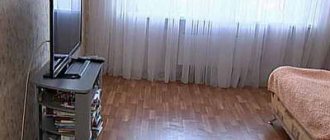A statement of claim regarding the procedure for using residential premises will help resolve issues of cohabitation. Since we are talking about going to court, it means that there is a violation of the rights of persons living in the same residential premises. There is no mutual agreement on the procedure for using such premises. People cannot agree on who will live in which room. And how to use common areas, etc.
A dispute can arise both between the owners of common joint or shared property, and with the participation of family members. Who also have the right to live in housing. The use of residential premises means that citizens will actually live in these residential premises, and not use them for some other purpose.
The main thing in resolving such disputes is to respect the rights of all citizens living in the apartment. The court will take into account the size of individual rooms and the established procedure for using the living space.
Using the above example of document preparation, you can independently draw up a statement of claim based on the specific circumstances of your situation. Just describe: how it all started, what relationships arose, how this situation developed and what it led to. Which forced me to go to court.
:
Statement of claim regarding the procedure for using residential premises
When to file a claim for the use of residential premises
It is possible to divide a living space only when it is a separate house. When there is a possibility of reconstruction and redevelopment of a residential premises. Including equipment for a separate entrance for each owner. Each newly created residential building must have independent common areas. Due to technical features (engineering and technical features of common areas), an apartment in an apartment building is not subject to division in kind.
In such cases, conflict resolution is possible only by determining the procedure for using the apartment. When tenants are unable to independently resolve disputes about use, such an order is established by the court.
A statement of claim regarding the procedure for using residential premises is submitted to the district court at the location of the disputed housing. The plaintiff can also file claims for restoration of housing rights at his place of residence.
The state duty is 300 rubles. If the statement of claim for the procedure for using residential premises includes other demands (to be recognized as a family member, for moving in, etc.), the state fee is paid for each such demand.
Vector Prava +7(499) 502-55-87, +7-926-983-00-55
Legal consultation by phone:
Offices in Moscow and the Moscow region: Directions
Determining the procedure for using residential premises. Determining the procedure for using residential premises is a dispute that has arisen between the owners of residential premises regarding the use of a residential property of common ownership.
Judicial practice shows that determining the procedure for using residential premises through the court is most often necessary for participants in common property. The basis for the emergence of common shared ownership of residential premises can be the purchase of residential premises (apartment) by two or more persons, the receipt of premises by inheritance by several heirs, as well as as a result of the allocation of shares in common joint property.
Common ownership of property is shared, except for cases where the law provides for the formation of joint ownership of this property. As a general rule, ownership, use and disposal of property in common ownership is carried out by agreement of all owners. In accordance with Art. 247 of the Civil Code of the Russian Federation, a participant in shared ownership has the right to be given for his possession and use a part of the property commensurate with his share in the right. If this is not possible, he has the right to demand appropriate compensation from other participants who own and use the property falling to his share.
Determining the procedure for using residential premises with payment of compensation may give rise to a lawsuit if a verbal agreement cannot be reached. Typically, the procedure for determining the use of residential premises is decided by oral agreement between the owners. An oral agreement on the procedure for using the premises does not require any additional formalization. However. Often disagreements arise between owners regarding the determination of the procedure for using residential premises that are in common ownership. In this case, the owners can enter into a notarized agreement that agrees on the procedure for using the residential premises. If the participants in the common property have not reached the order of use, then it is determined in court (the corresponding claim is considered), where the right to use the residential premises in the apartment is determined. The decision and conclusions of the court on the impossibility of determining the procedure for using residential premises occur only in exceptional cases. Most court decisions precisely determine the rights to use residential premises.
If you have such disagreements and it is not possible to resolve them on your own, before filing a claim in court, you should seek help from a professional lawyer in housing disputes. This will help you save your time and effort, and also guarantee you the most favorable resolution of the current conflict. When going to court, it is necessary to take into account some nuances. For example, only the owner of the property, and not the person registered in the apartment, has the right to file a claim to determine the procedure for using residential premises. These concepts are clearly separated by law, however, often a person who does not have a legal education may not understand this difference. In this case, a sample claim to determine the procedure for using residential premises will not even help you. But legal disputes are not a cheap pleasure, so it is better to immediately turn to specialists. The lawyers of MGK “Vector of Rights” will help determine your legal status, i.e., explain the range of your rights and obligations, their content, and will also help you establish your options and work out a strategy for resolving your specific case that is most favorable for you. Our lawyers know everything about how to determine the procedure for using residential premises. It is also necessary to distinguish between a statement of claim to determine the procedure for using residential premises under a social tenancy agreement, claims for the allocation of a share in the right of common joint property and claims for the allocation to a participant of the common property of his share in kind. The allocation of a share in kind, in accordance with civil law, terminates the regime of common ownership of an apartment or house for one or more owners. Making such a decision is the basis for obtaining a certificate of state registration of ownership of part of the residential premises. In this case, in the certificate of state registration, for example, room No. 1 in an apartment, a part of a residential building consisting of specific premises, etc. is registered as an object of right. The subject of law, in this case, becomes the sole owner of the specified property.
When determining the procedure for using residential premises, a participant in shared ownership may require the provision of both an isolated room in the apartment and a non-isolated one. The court may leave the passage room in the apartment for the common use of the owners. The size of the room(s) allocated to the owner does not have to correspond exactly to the owners' ideal shares. Based on the resolution of the Plenum of the Supreme Court of the Russian Federation No. 14 “On some issues arising in judicial practice when applying the Housing Code of the Russian Federation” dated July 2, 2009. It is believed that the provision of a room for use by one of the owners that exceeds the size of his share does not violate the rights of the other owner to own a common living space, since the right of shared ownership does not terminate.
It is also necessary to keep in mind that if the owners determine the procedure for using residential premises in court (or by agreement of the parties), then the established conditions for using the apartment apply only to them. In case of alienation (sale) of your share to third parties, by virtue of clause 3 of Art. 308 of the Civil Code of the Russian Federation, the new owner does not receive the same fixed procedure for using the residential premises from the seller, and can be revised again at the request of other participants in the common shared ownership.
When going to court, the statement of claim to determine the procedure for using residential premises is considered in accordance with paragraph 7 of paragraph 1 of Art. 23 of the Code of Civil Procedure of the Russian Federation by magistrates at the location of this property, in accordance with Art. 30 Code of Civil Procedure of the Russian Federation.
When considering cases to determine the procedure for using residential premises, the following are taken into account:
• The share of each owner in the common joint property (residential premises);
• The established procedure for using residential premises before going to court;
• Living space layout;
• Availability of an isolated and walk-through living area of the apartment; • The need of each owner to use a certain part of the residential premises;
• Composition of the family of the owners of the residential premises;
• Availability of other residential real estate properties by the owner of the residential premises.
If you need to establish a procedure for the use of residential premises, and you cannot solve this problem with the other owners, the experienced lawyers of MGK Vector Prava will give you a full and comprehensive consultation, help you draw up the text of an agreement on determining the use of residential premises, and will also represent your interests in court from filing a statement of claim to enforcement proceedings.
Information and documents required for the provision of services:
• Certificate of ownership of residential premises;
• Unified housing document (extract from the house register for the residential premises, and a card for registering residents of the residential premises);
• Floor plan with explication of BTI for residential premises;
• Documents confirming the established procedure for using the residential premises (photos, payment receipts for the purchase of furniture and household appliances, etc., located in the apartment);
• Documents confirming the relationship of family members living (registered) with the owner of the residential premises.
List of services provided:
• Legal advice on determining the procedure for using residential premises;
• Pre-trial procedure for resolving a dispute to determine the procedure for using residential premises;
• Representation of interests in determining the procedure for using residential premises in courts;
• Enforcement proceedings.
The procedure for using non-residential premises has its own subtleties and nuances. Therefore, it is also better to entrust the determination of the procedure for using non-residential premises to our lawyers.
In addition, we can explain the procedure for using residential premises for non-owners or answer the question “Who determines the procedure for using residential premises under the contract.”
Resolution of a claim regarding the procedure for using residential premises
When considering a claim, the court examines the following circumstances:
- the actual procedure for using housing
- the need of each owner for residential premises
- the possibility of cohabitation and other facts necessary to resolve the dispute
During the consideration of the case, the court, having examined the materials, examined the evidence and listened to the arguments of the parties, is obliged to make a decision. In such disputes, there are also cases of refusal to satisfy the claim.
The main reasons for such refusal are:
- a large number of owners and a small living area
- the proposed options for using housing violate the rights of other owners
- two or more owners in a one-room apartment
- lack of evidence of creating obstacles to moving into or living in a residential area
Judicial practice is diverse. And it is impossible to predict all the reasons for refusal. Along with this, when the court has refused to satisfy the requirements, you can make an alternative application to the court. For example, with a statement of claim for moving into a residential premises.
Why you shouldn’t neglect the help of a lawyer
When the court determines how the premises in the apartment should be used, then each of the residents has the right to calmly install a lock on their room. If other owners create obstacles, it is possible to resort to the help of the police or bailiffs.
Before you begin work on determining the procedure for using an apartment, it is useful to talk with a lawyer. He will study the situation and provide all necessary advice. The specialist will also tell you about all the possible risks that may lie in wait on the way to your goal.
If assistance in drawing up a claim and its support in court is needed, then a lawyer will also take on this work.
Remember that the best option would be to amicably agree on the procedure for sharing the apartment. This will help save time, nerves and finances.
An alternative to a claim for the procedure for using housing
There are cases when the court, accepting a refusal to satisfy a claim, determines the plaintiff’s right to receive compensation for the use of an apartment.
However, as determined by the Constitutional Court of the Russian Federation, such a rule of law may be applicable to a participant who has submitted a request for the allocation of a share (in more detail, an agreement on the allocation of a share) and only in the presence of the following circumstances:
- the allocated share is insignificant. The share size is small.
- isolating a part in kind is unacceptable. In an apartment, for example, it is impossible to allocate 1/50 of the share in reality.
- lack of significant interest of the owner (who declared the allocation of a share) in the use of the disputed property
Citizens who do not live in the apartment should, simultaneously with the claim to determine the order of use, file a claim for moving into the residential premises. If keys to the front door are not issued, file a claim to remove obstacles to the use of the apartment.
Recommendations before going to court
It is necessary to determine the regime for the use of residential premises in court when a voluntary agreement has not been reached between the co-owners. The claim must provide evidence that the interested party has barriers.
Below are other useful tips:
- One of the attachments to the statement of claim should be an explication of the apartment. This will show the technical characteristics of the room the plaintiff is claiming.
- If the allocation of the desired room is due to health conditions, the presence of children, or other objective reasons, the application provides a link to the relevant evidence.
- When determining the procedure for using an apartment is inextricably linked with forced eviction, certificates from the police may be required. It is the district police officer who often records the fact of obstacles on the part of the defendant.
- In some situations, courts pay attention to the ratio in which utility bills are paid between owners. Therefore, you can attach the relevant receipts.
- Provided that the plaintiff has made repairs in the disputed room, it is recommended to include evidence of payment of the relevant expenses.
When the order of use of the living space is determined, the owner of the room has every right to put a lock on the door and use it at his own discretion. In this case, you must comply with the requirements of the Housing Code of the Russian Federation.
Author: Oleg Vladimirovich Roslyakov, source.
Execution of the decision on the procedure for using residential premises
So, the court made a decision to satisfy the plaintiff’s claims. Established procedures for using the premises. Please note that all family members living together have the right to use common areas.
How to demand enforcement of a decision? First, the writ of execution is sent with an application to initiate enforcement proceedings to the bailiff. The official will set a deadline for the defendant to voluntarily comply with the requirements. In case of non-compliance, he will take enforcement actions. The claimant (plaintiff) moves into the apartment with the assistance of a bailiff.
After a decision has been made on a claim regarding the procedure for using residential premises, the claimant may file an application with the court for an explanation of the court decision in order to establish the fact of non-fulfillment by the debtor and assign duties to the bailiff to carry out compulsory actions.
The court's decision
As a rule, several hearings take place in a dispute, during which the judge finds out all the important details. When the claim is satisfied, the court determines which room will go to each owner for use. In addition, the issue of utility bills can be resolved.
Compensation for legal costs is also awarded. It is recovered from the remaining defendants, including on the basis of a writ of execution.
Like any other judicial act, a court decision on the use of an apartment can be reviewed by appeal. You have a month to file a complaint. After the case is considered by the appellate court, the introduced regime for using the apartment will receive full legal confirmation.
Shared ownership: features of the relationship between co-owners
In Russian legislation there are two definitions of property – common and shared.
Joint ownership means the fact of simultaneous ownership of one property by several persons. This can happen for many reasons, for example, if several people buy one apartment together or they inherit living space. Property can be divided not only between relatives and spouses, but also between persons who are not related by family ties.
Shared ownership means this type of common property (apartment, house, room), in which the shares of all co-owners are clearly distributed (Article 209 of the Civil Code).
In a situation where the co-owners are unable, for whatever reason, to agree on the rules and establish a compromise procedure for owning and managing the joint living space, they can exercise the right to liquidate their legal relations on the principle of joint ownership.
The procedure for transferring property from the category of joint ownership to shared ownership can only be carried out by a court decision (Article 27 of the Civil Code). The agreement must be drawn up in the form of a notarial deed.
Relations between the co-owners of an apartment regarding the procedure for use are built on the principle of their participation in its value/profitability/unprofitability (Article 245 of the Civil Code). Unlike relations in the ownership and management of joint property, shared relations are regulated by law.
When several people share an apartment, therefore the order of use, the ratio of joint ownership or management of the property, this can cause many problems. After all, the order of relations between shared residential property, in contrast to commercial property, depends on the influence of many factors - material and emotional-psychological.
Therefore, it is often extremely difficult to reach a compromise regarding the procedure for using common shared living space. The comfort of living together may be disrupted, for example, due to the decision of one of several co-owners to sell/rent one of the rooms to an outsider.
The way out of the situation is an application for the abolition of joint ownership of the apartment, i.e. a severance of relations in which all co-owners have equal rights to use shared real estate.
There are two ways to do this. The first is to sign the appropriate written agreement with the notary. The second is to request a court decision to determine the procedure for using shared living space.







